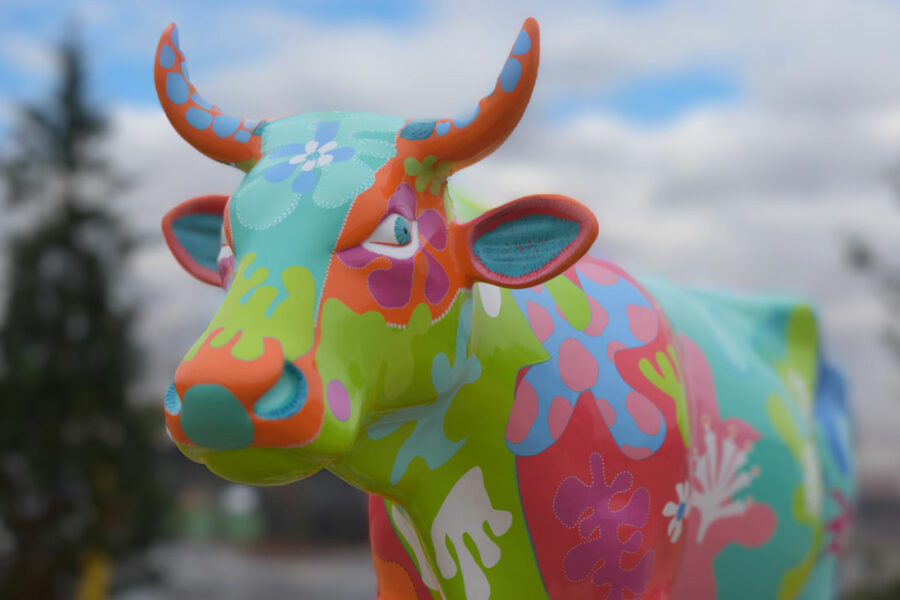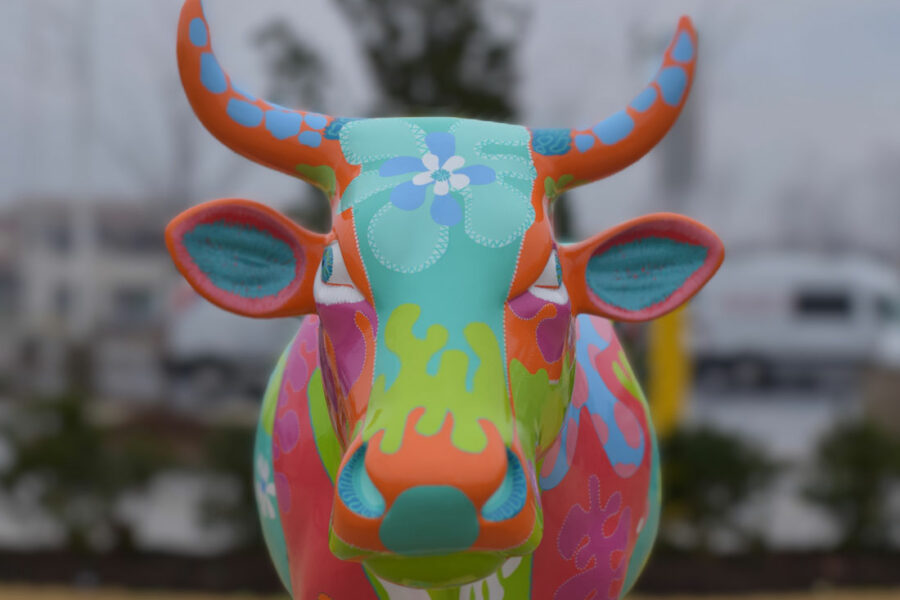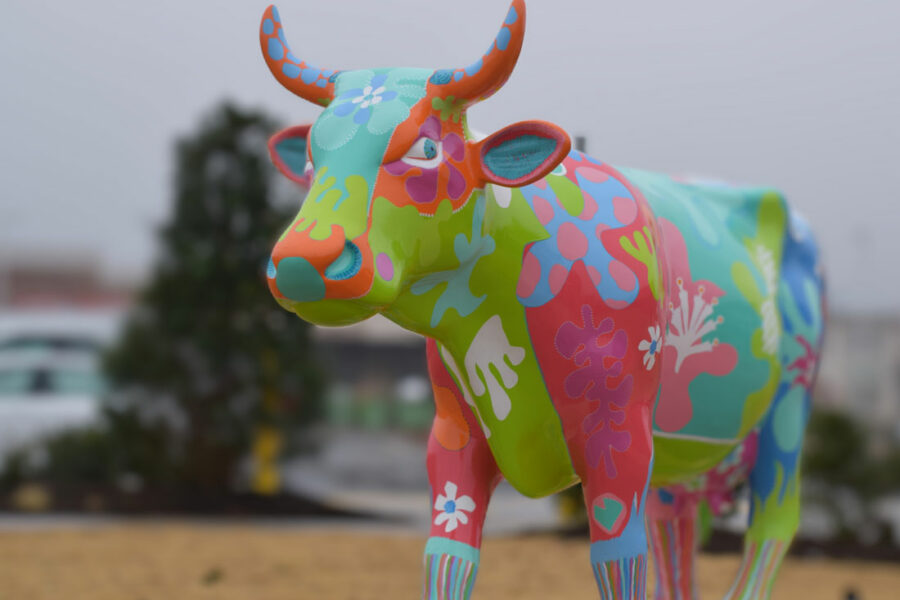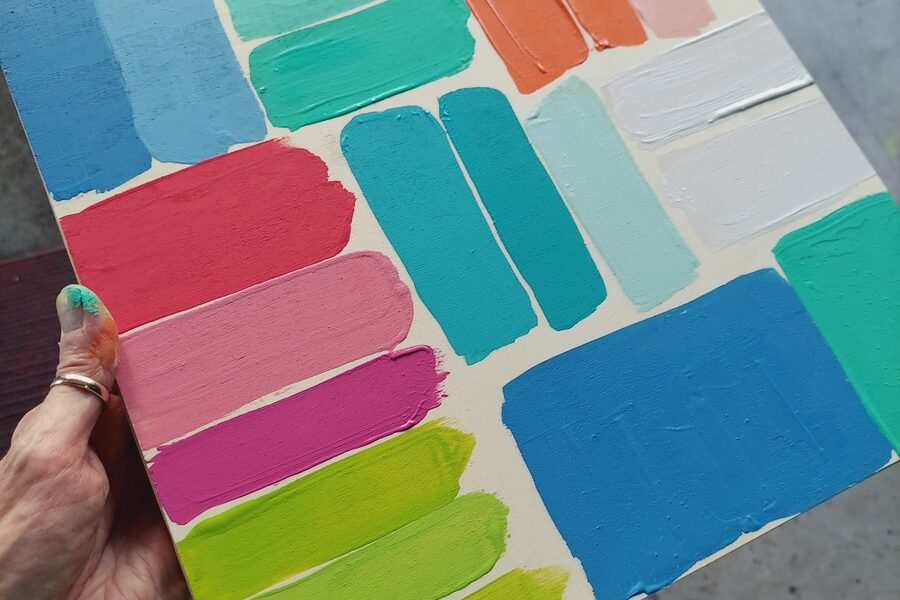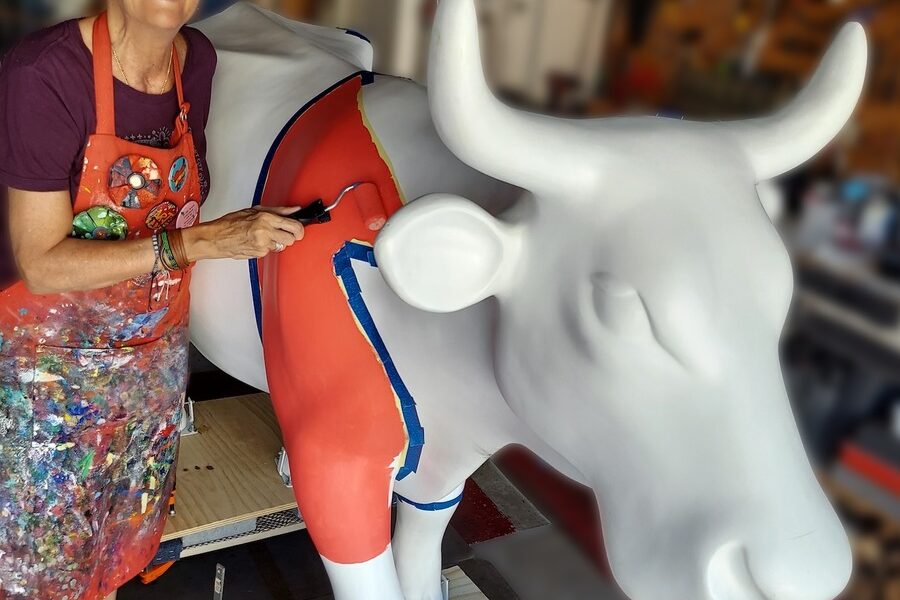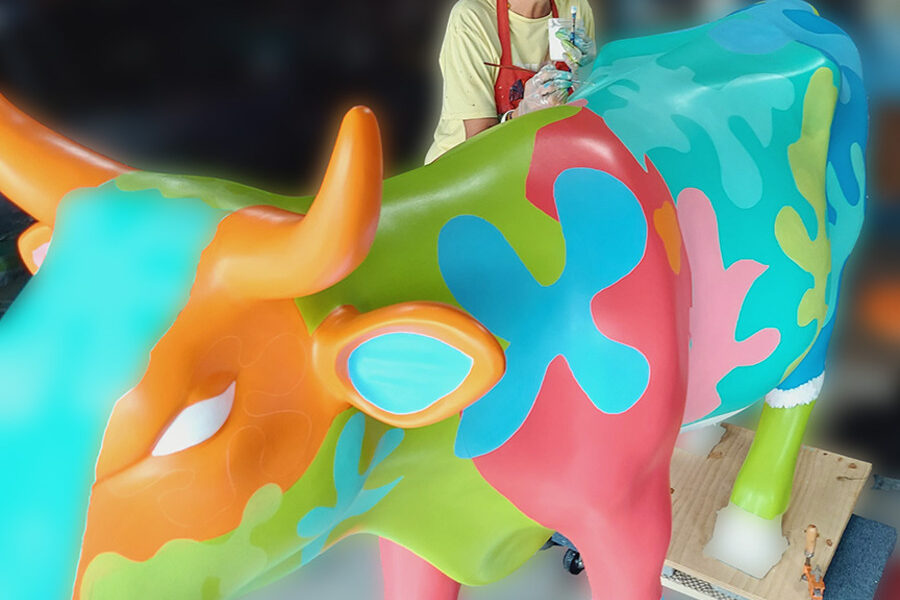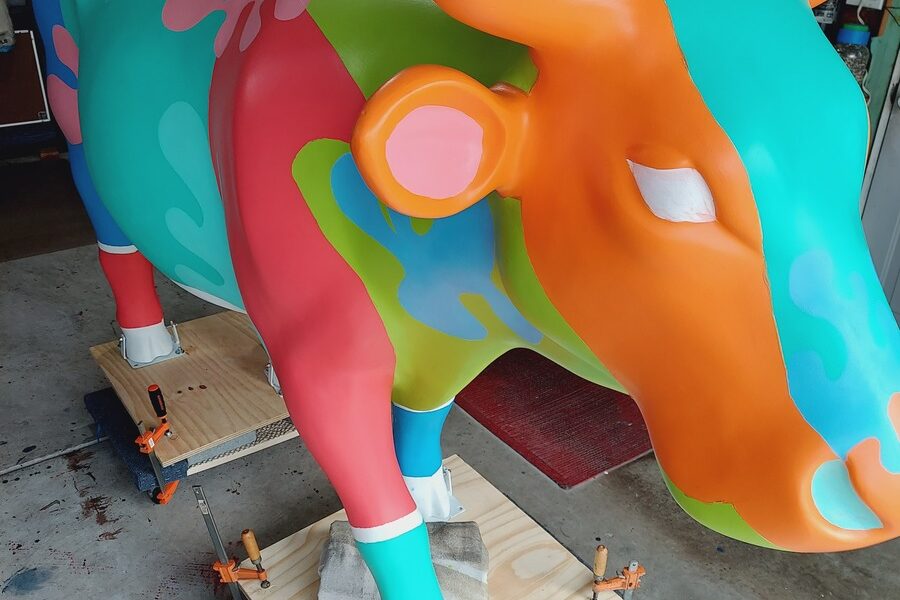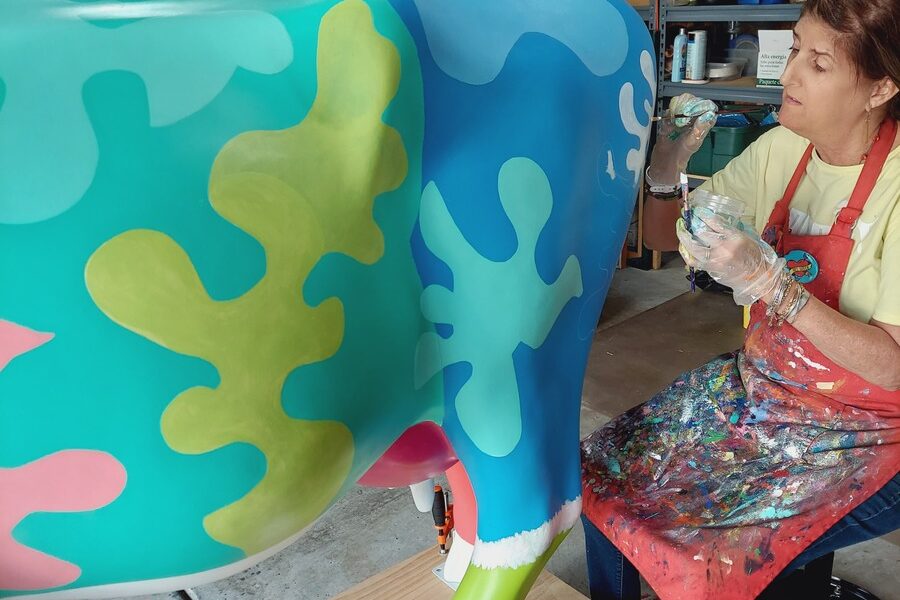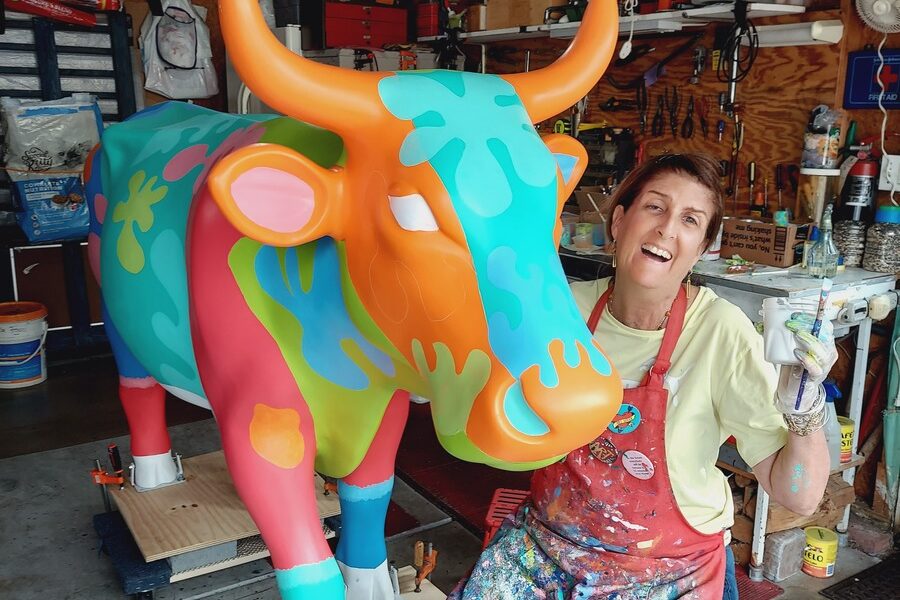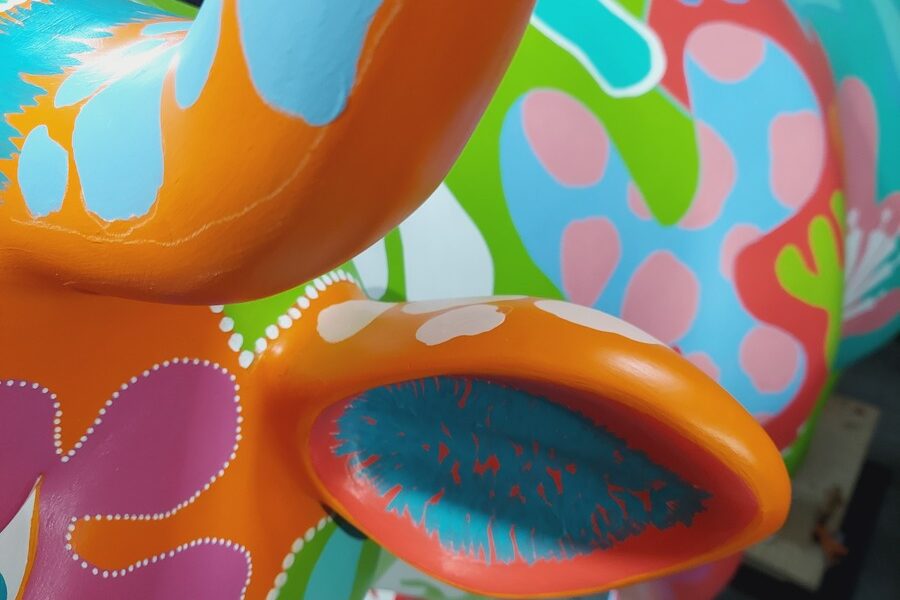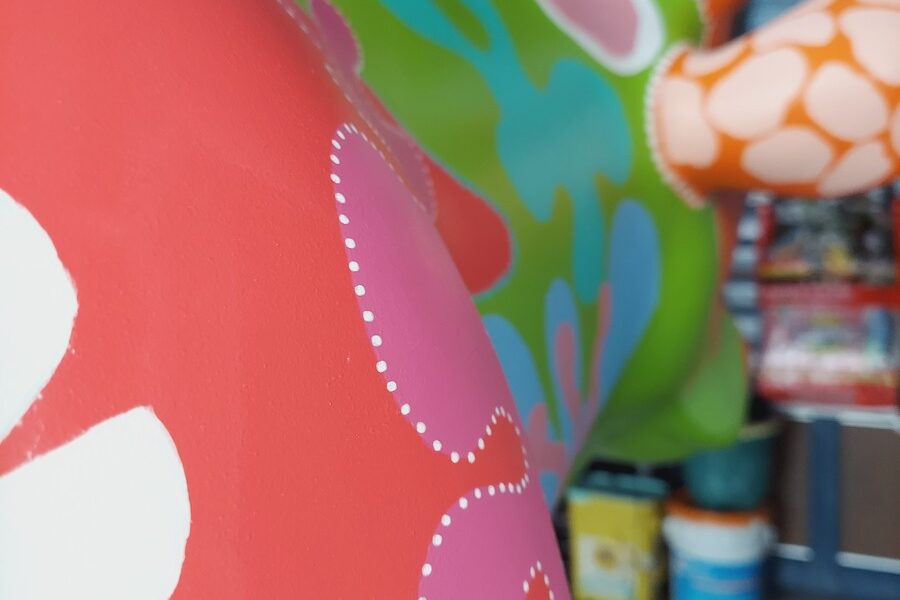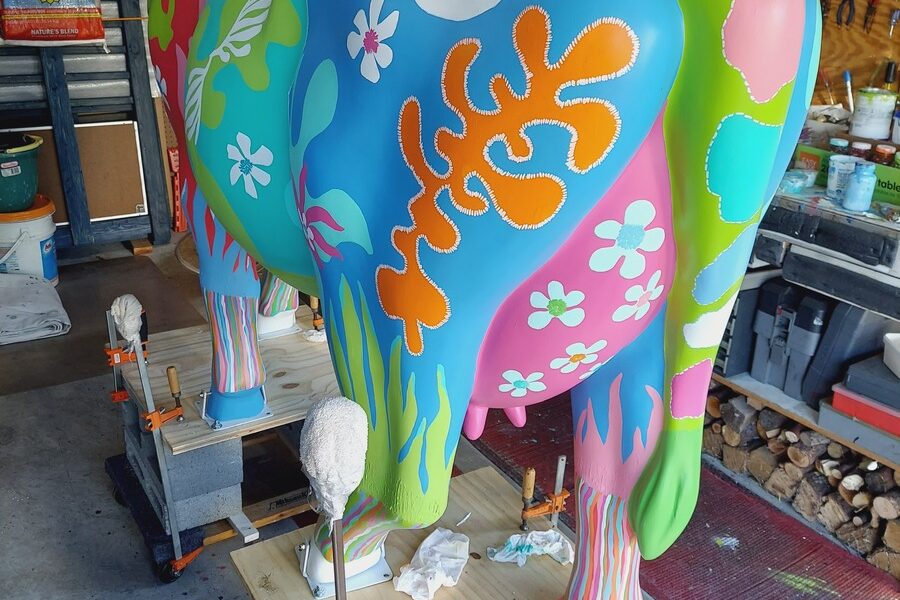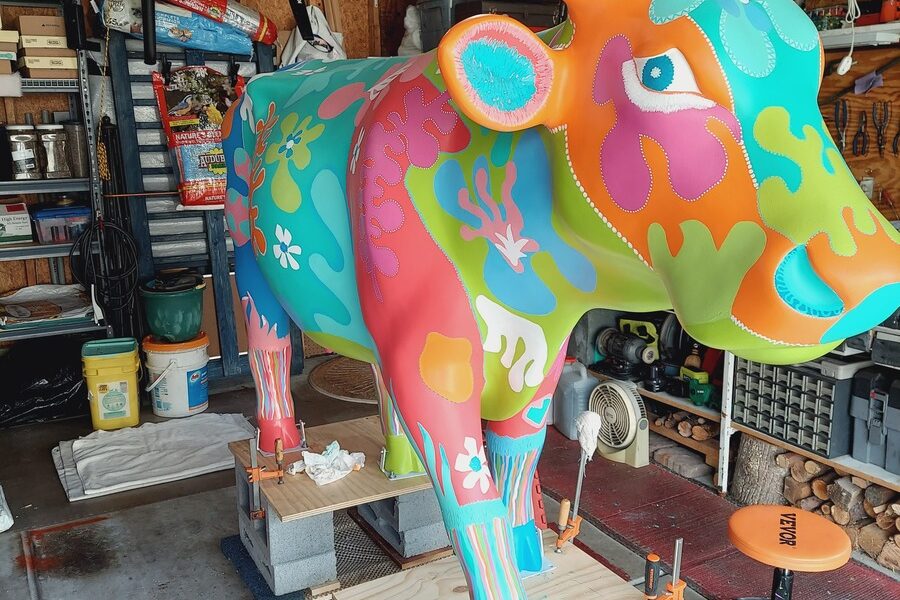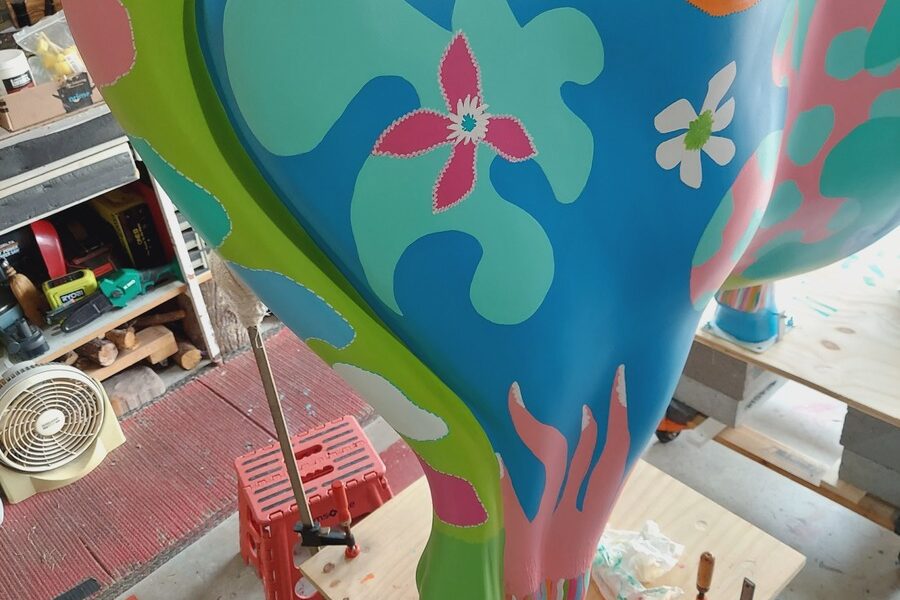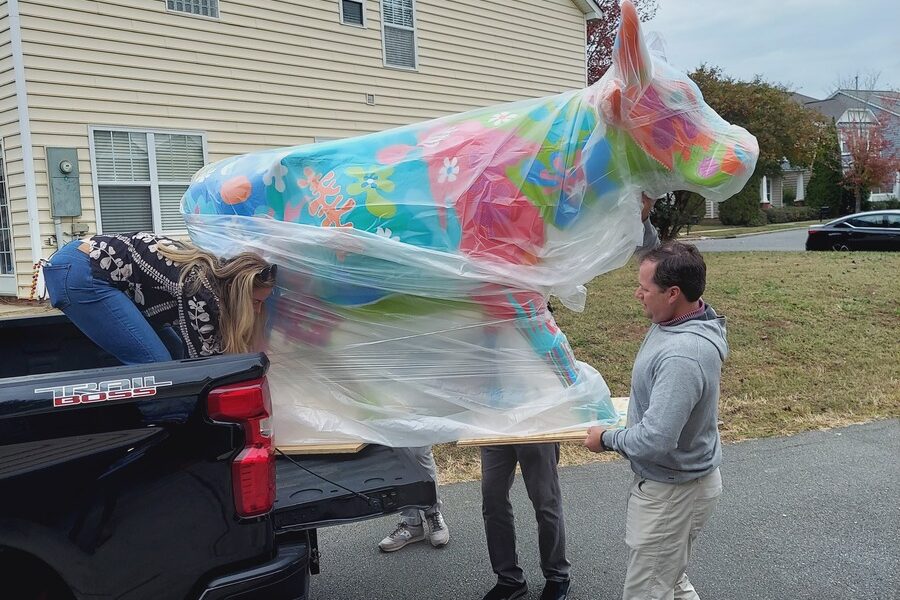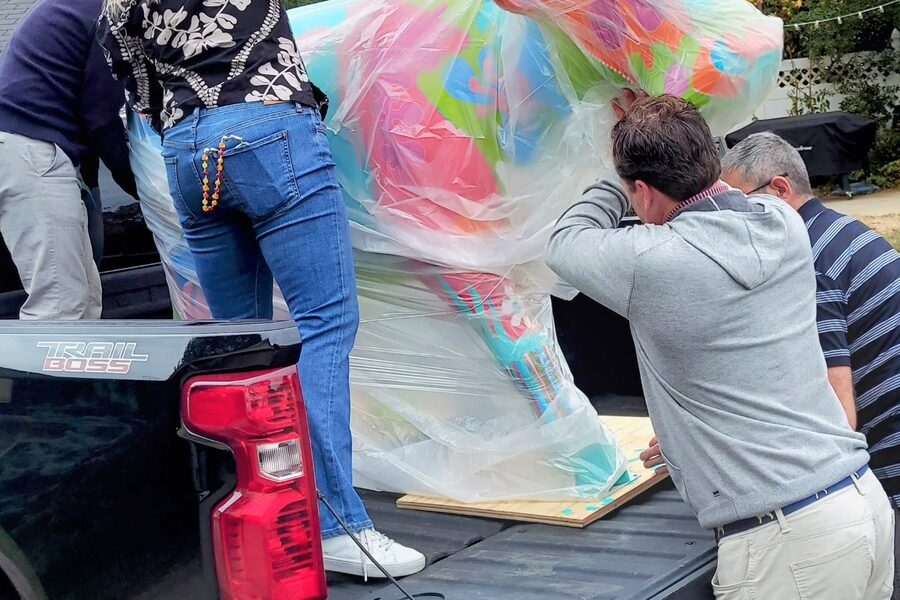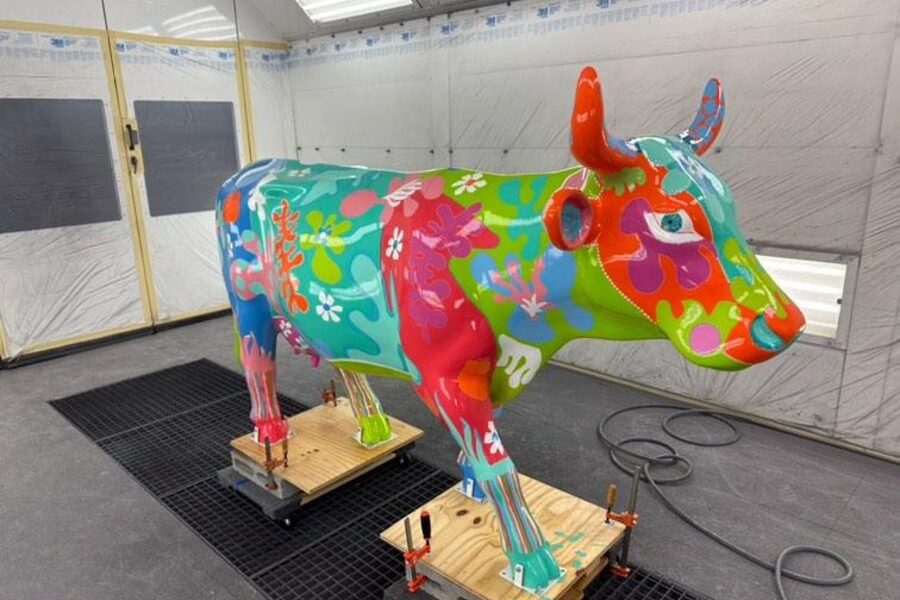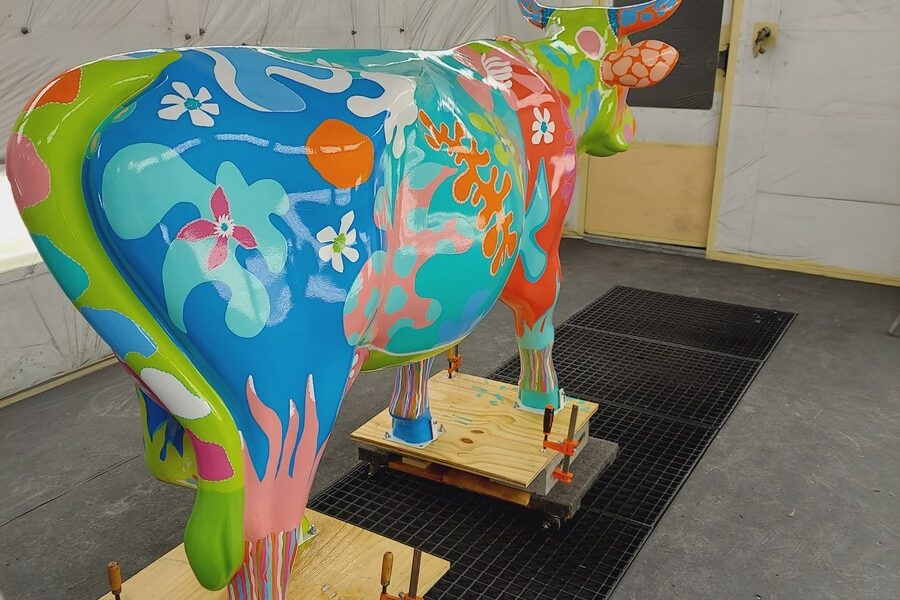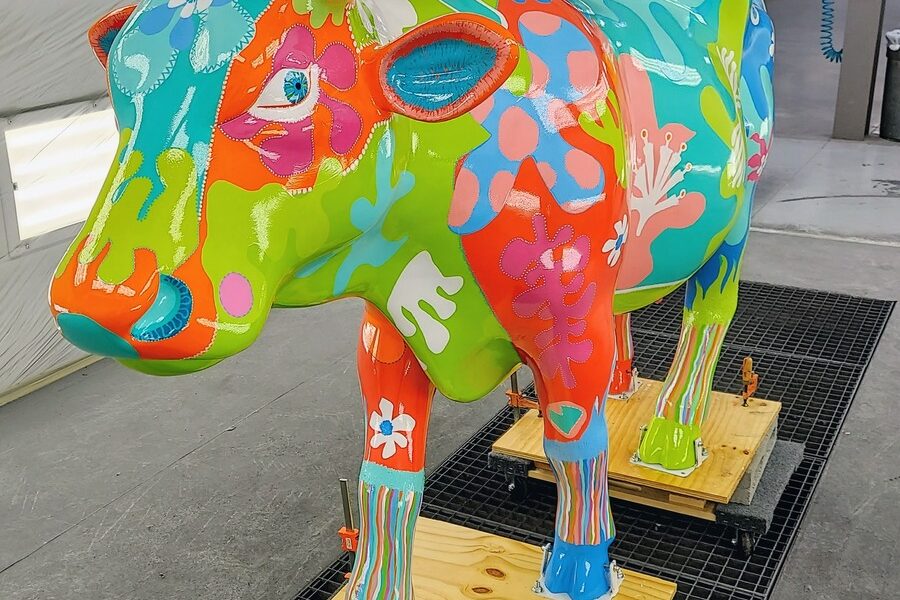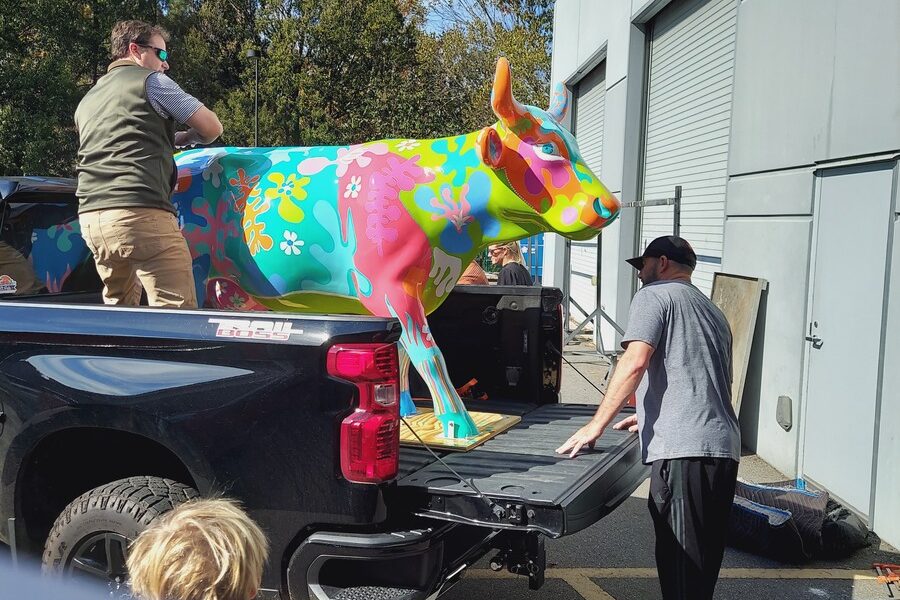Emmaline at Harris Farms
Explore the Legacy of the Harris Family with Emmaline
Nestled in Mooresville, NC, a commemorative cow lovingly named Emmaline stands proudly, symbolizing the rich legacy of the Harris Family’s dairy farm. This sculpture provided by Cow Parade, serves as a tribute to the historic farm and generations that once thrived on the very land that is now Harris Farms Shopping Center. The story behind Emmaline is one of tradition, hard work, and the enduring spirit of the Harris Family. For generations, they tended to their acreage, nurturing the land and producing quality dairy products that were beloved by the local community. Visitors of Emmaline and Harris Farms can appreciate the history and heritage of the Harris Family, exploring the significance of their contributions to the local dairy industry. In addition to being a symbol of the past, Emmaline also serves as a bridge to the present, connecting visitors through social media. By following the links provided on this page, users can engage with like-minded individuals who share a passion for art, culture, and the preservation of history. Emmaline is a living testament to the legacy of the Harris Family and a reminder of the rich tapestry of stories woven into the fabric of Mooresville. So take a moment to explore, to learn, and to appreciate the roots from which we all grow.
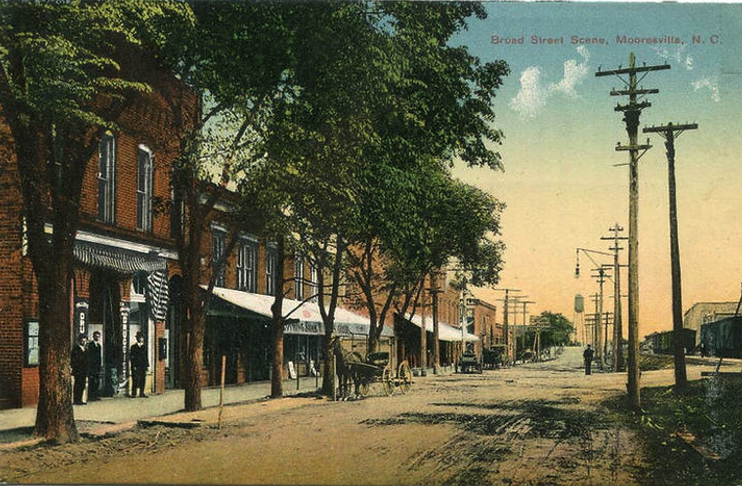
Downtown Mooresville, NC during the agriculture boom (early 1900’s).
Credits: Time Pieces: A collection of Mooresville’s history
To learn more about the town of Mooresville: Mooresville, NC History
Emmaline’s Bright Color Choices: A Whimsical Tribute to Harris Farms’ Vibrant Legacy in Mooresville, NC
This fiberglass sculpture does more than just add charm; it reflects the cultural heritage that shapes the community. The bold color choices and quirky patterns pay homage to the lively spirit rooted in our local history, tracing back to the original Harris Farms, the dairy farm that once thrived in this area. In more recent years, the family’s favorite Bovidae resident was Emmaline; A friendly, loving cow who bonded with family members on the farm. The sculpture is named in her memory.
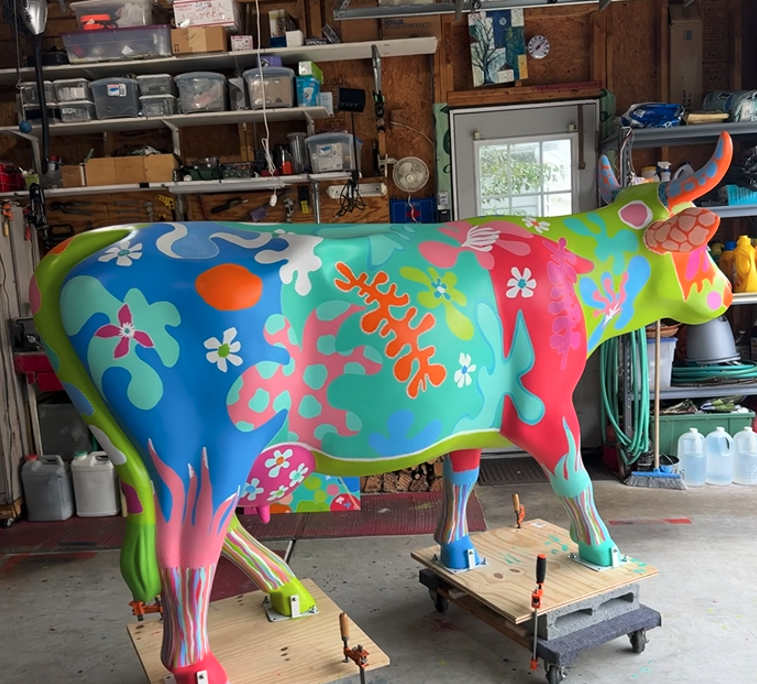
Emmaline in Tina Alberni’s workshop.
About the Artist: Tina Alberni
Tina Alberni is a visual artist based in Charlotte, North Carolina, who actively participates in the local art scene.
Her artistic journey began in New York, her birthplace, and continued as she moved to Puerto Rico, Colombia, and Miami during her formative years. After earning a Bachelor’s degree in Art Education from Florida International University, Alberni taught middle and high school art in Dade County, Florida while simultaneously showcasing her artwork in exhibitions across Colombia, Europe, and New York before the age of 30.
Throughout the past three decades, Tina Alberni has exhibited her work in over 100 solo, group, and virtual shows both in the United States and abroad, receiving recognition and awards along the way. She has received grants from the Charlotte Arts and Science Council, earned first-place awards, been a 2-time Public Arts Cities Program artist of ArtPop Street Gallery, had her digital artwork displayed on multiple digital billboards in Miami, Charlotte, Barcelona, and Austria. Recently, she was invited to showcase her digital artwork at The Foundry Gallery in Dubai, UAE, Piuda Gallery in Seoul, Korea and with The ArtBox project in both Miami & Switzerland during Art Basel weeks. Currently, she has a solo show at the Bill & Patty Goerlick Galleries in Charlotte, She was among 70 selected from 1000 applications to showcase her work at the Contemporary Art Museum of Raleigh through November 2024. Upcoming featured exhibitions include the Discovery Place in Uptown Charlotte, and Cabarrus Art Council Galleries through April 2025.
Alberni’s work has been published in print and online, and her pieces are found in private and public collections such as Atrium, Nevins Center, Novant, Johns Hopkins Heart & vascular Institutel (Baltimore), National Marfan Foundation, (St. Louis) La Casa de la Cultura del Banco Ganadero (Bogota), The Style Merchant (Charlotte) Liga Contra el Cancer (Miami), CRI of South Florida (Miami) Ace Tuxedos (Coral Gables) Consulado General de Colombia (Miami), and Sala de Exposiciones Larrea (Madrid) among others.
Throughout her career, she has explored various paths, including co-owning an art gallery, teaching and working in arts administration, and as Creative Director of web/graphic design. She has also served on non-profit boards and on several jury panels and has been an invited guest speaker.
With a penchant for artistic experimentation, Alberni has delved into a diverse range of mediums, subjects, and genres. Her work often embodies her personal experiences and exhibits influences from her background in printmaking and graphic design. Alberni’s artistic process is rooted in automatism, allowing ideas to gradually emerge and take shape as she creates each piece. She always works in a variety of mediums within each series. Her artistry encompasses a broad range of mediums, techniques, and genres, reflecting her ongoing exploration and experimentation. She expertly combines mixed media, collage, painting, and other artistic approaches to create visually captivating and conceptually layered pieces. Her use of bold colors and intricate compositions reveals her unique artistic vision.
Over the years, Alberni realizes that the profound narratives she weaves with vibrant colors evident throughout her work pay homage to the rich tapestry of Andean culture. This artistic choice is a profound tribute to the heritage that holds a special place in her heart due to her bi-cultural heritage and upbringing in Colombia.
Her creations address pressing issues such as climate change, the plight of endangered animals, the essence of human existence, and the impact of technology on society. Through her artwork, Alberni seeks to stimulate dialogue, provoke thought, and raise awareness about these crucial matters.
In recent years, Alberni has focused on her studio practice and is exploring the realms of AI and digital art in Web3, to connect with a wider audience. Her creations stem from her original artworks. Many hours include photographing and working in collaboration with AI, then further refining a using digital programs such as Photoshop, Procreate, and various other graphic programs.
Her career pursuits include accepting commissions, forming corporate partnerships, collaborating with fellow artists, consulting in the trade industry, working with interior designers, exhibiting her work in unconventional venues, and finding digital projects and exhibitions with artists and in venues around the world.
She is a full-time artists and currently has 2 studios at the Vapa Center in Uptown Charlotte. Her website is tinaalberni.com and you can follow her on IG @tinas_art_beat.
Discover the History of the International Cow Parade
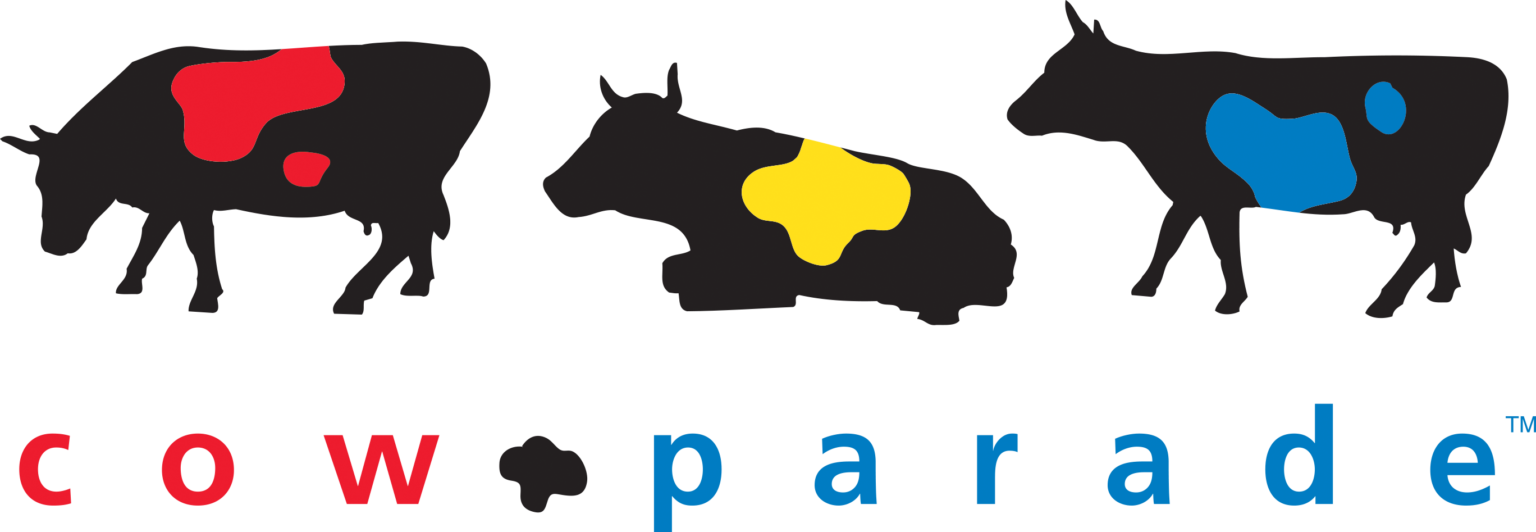
The International Cow Parade is an engaging global art event that highlights creativity, culture, and community involvement through the vibrant decoration of life-sized fiberglass cows. Since its start in 1999, this thrilling event has captivated art lovers, residents, and visitors in cities around the world. But what sparked this delightful parade, and how has it influenced communities everywhere?
Origins of the Cow Parade
The Cow Parade began in Zurich, Switzerland, in 1998, when local artist Walter Knapp proposed a project aimed at beautifying public spaces while raising money for charity. By decorating a series of fiberglass cows, the project celebrated the city’s dairy farming history. Each cow served as an engaging canvas, allowing artists to showcase their unique styles and messages. This inventive approach quickly drew public interest and created a buzz that spread throughout the city.
Global Expansion
After its successful debut in Zurich, the Cow Parade rapidly expanded to cities across the globe. Each city added its own flair, reflecting local culture and artistic elements. Chicago held its first parade in 1999, featuring over 300 cows decorated by local artists, while New York showcased 500 cows in 2000, with themes ranging from Broadway to the Big Apple’s skyline. This global movement not only embraced diversity but also fostered connection through the universal language of art.
Artistic Expression
Artists from various backgrounds transformed the plain fiberglass cows into extraordinary works of art. Each cow narrates stories or represents themes linked to local culture, environment, or pressing social issues. For instance, one cow in London depicted the city’s iconic red telephone booths, while another celebrated environmental conservation with a design that featured trees and wildlife. The lively and unique designs not only attract attention but also spark conversations among viewers, fostering a shared cultural experience that goes beyond mere aesthetics.
Community Engagement
The Cow Parade stands out for its remarkable ability to engage entire communities. Local businesses, schools, and non-profit organizations often join forces to fund the project, illustrating the importance of community involvement. In cities like Chicago and Dublin, schools have organized events for students to learn about art and public space while participating in cow decoration workshops. Once displayed, these cows typically enter charity auctions, with proceeds going to local causes. In 2022 alone, the Cow Parade helped raise millions of dollars for various charitable organizations worldwide, further cementing its dedication to community support.
A Lasting Legacy
The Cow Parade has left a meaningful legacy in every city it has touched. This event not only enhances public spaces by making art accessible to everyone but also encourages collaboration among artists, businesses, and community members. In places like Seattle and San Francisco, the parades have become annual traditions, creating a sense of pride and camaraderie. The Cow Parade exemplifies how art can transform everyday life and cultivate joyous experiences for many.
Final Thoughts
The International Cow Parade is more than just a charming display of decorated fiberglass cows; it is a grand celebration of art, culture, and community spirit. From its initial initiatives in Zurich to its current global presence, this event has crossed borders while making a significant impact on the communities it influences. As art continues to play an essential role in society, the Cow Parade remains an inspiring example of how creativity can bring people together, encourage conversations, and enrich our cultural fabric.
Emmaline in the Workshop
Photos provided by Tina Alberni


